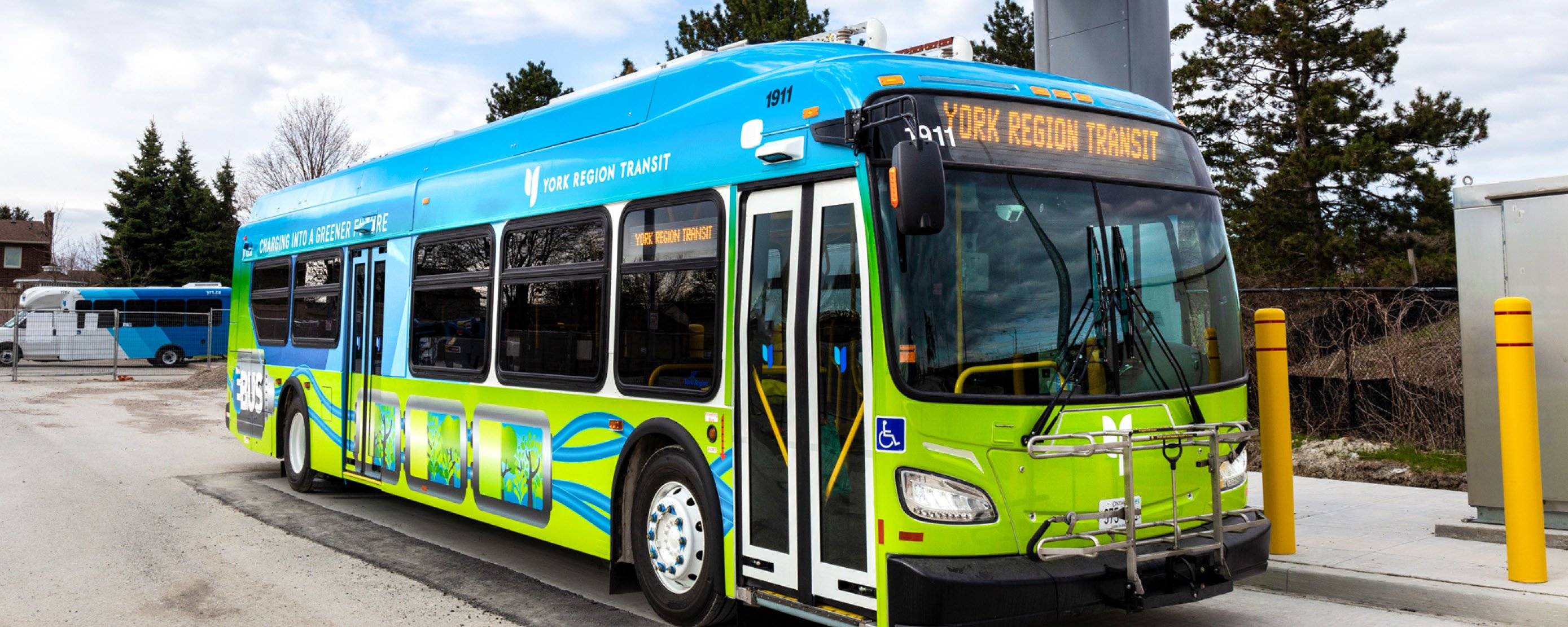
Electric Bus
Accessible formats or communication supports are available upon request by contacting 1-866-668-3978.

YRT is going electric. YRT’s first battery-electric bus (e-bus) began service in early 2020. Since then, the program has grown to include 14 e-buses with plans to add 180 more by the end of 2028.
E-buses have many benefits over a typical, diesel bus and perform just as well. Some of the benefits of electric buses include lower fuel and maintenance costs, reduced noise, smoother driving experience and reduced emissions (zero tailpipe emissions).
YRT’s goal is to have a fully electric bus fleet by 2050. This will help support York Region’s Climate Change Action Plan goal of becoming a net-zero Region by 2050. Over the next few years, YRT will:
- Add 180 electric buses to its fleet
- Install 91 battery electric chargers and on-route charging stations at select bus garages and terminals
- Upgrade bus garages to include solar power and battery storage that can be used for bus charging
Once in service, the 180 electric buses are expected to reduce emissions by approximately 15,982 tonnes annually.
Frequently Asked Questions
How do the e-buses charge? |
|
For on-route, fast charging, an overhead station called a Pantograph is located at the Newmarket Terminal. The e-bus charges underneath the Pantograph before picking up passengers at the platform. This allows e-buses to charge in under 10 minutes. When e-buses are not in service and parked at the bus garage they are plugged in overnight for a full charge in preparation for the next day's service. |
How often do e-buses need to recharge? |
|
Our current electric bus fleet can travel up to 220 kilometres between charges. Our next generation of e-buses will be equipped with larger batteries and are expected to travel approximately 400 kilometres between charges. The distance travelled between charges depends on various factors such as bus type, passenger loads, temperature/weather conditions and traffic patterns. Some e-buses may require a charge after every trip, while others may last longer. This is something YRT staff continue to monitor and analyze. |
Does the distance the e-bus travels on a full charge vary during the winter and summer? |
|
Yes, and this will continue to be tested and monitored as the program expands. |
Do e-buses recharge with passengers on board? |
|
No. E-buses charge underneath the overhead station at Newmarket Terminal before picking up passengers at the platform. |
What does it sound like? How will I know I’m on an electric bus? |
|
An e-bus is substantially quieter than a typical diesel bus. Travellers do not hear the noises associated with engines and transmissions. The e-bus can also be identified by the lowercase “e” in front of the bus number. |
Are there any extra safety measures for pedestrians because the e-buses are so much quieter? |
|
Technologies including pedestrian detection/alert and driver assist have been added to the e-bus fleet. |
Why are you retrofitting your current facilities with solar power? |
| Using solar power will help decrease pressures on the local electrical grid, enhance resiliency to power outages, and ensure facilities can continue to operate and service transit vehicles sustainably. |
How are the new buses and facility upgrades being funded? |
| The total budget for this project is $389 million. It is being funded through a $136 million loan from the Canada Infrastructure Bank, a $76 million dollar grant from Canada’s Zero Emission Transit Fund and a $177 million investment from York Region. |
What was the Pan-Canadian Electric Bus Demonstration and Integration Trial? |
|
YRT participated in a multi-year initiative led by the Canadian Urban Transit Research and Innovation Consortium (CUTRIC). The demonstration and integration trial was multi-organizational with participation from TransLink, YRT and Brampton Transit. Participation in this trial allowed YRT to collect and share operational data that assisted us in understanding the requirements to operate a fully electric bus fleet. Thank you to our partners: |
